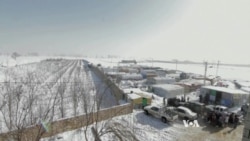Shielded by the thinnest of walls from the biting wind and snow outside, Syrian refugee Fatmi Zakour provides refuge to her two sons in the cradle of her arms.
Four-year-old Nayef and two-year-old Zakaria are unable to support themselves, and despite her best efforts, Fatmi is struggling to support them.
“Everything changed for us here,” said Fatmi, whose husband died in the Syrian war and who also has a seven-year-old daughter, Hayfa. “My husband was killed, and I have two handicapped kids. And my oldest daughter has heart problems - everything changed. We’re living in a tent now. We weren’t used to living in a tent. Everything is different.”
Recent weeks have seen the refugees, of whom an estimated 83 percent are women and children, blighted by the worst of Lebanon’s winter.
At least three are thought to have died amid plunging temperatures and heavy storms, while the efforts of aid agencies to help them have been set back by the conditions.
Some estimate there to be around 1.6 million refugees in Lebanon, of whom a large number reside in 1,400 temporary camps set up across the country.
Makeshift in their nature, these camps often lack access to basic necessities - a problem that is only exacerbated by the onset of winter.
“The difficulty is that we’re living in a tent,” said Fatmi, who lives a camp of 120 Syrians near Zahle in the Bekaa, a mountainous region where at least 400,000 refugees reside. “We’re afraid that it’ll fall down on us, with the snow and everything. That the kids will get cold. That they’ll get sick, even sicker than they already are. I would ask help for my kids. I don’t have anybody to help me with them. I need medicine, diapers, milk. All the medicine is really expensive and I’m unable to help them.”
Some help is being offered. In the wake of the recent storm, the Lebanese government teamed up with NGOs and sent out emergency doctors to try and help the afflicted.
Respiratory issues and infections were a major issue, but it is the chronic illnesses that pose the biggest problem, explained Ministry of Health doctor Fatima al-Moussawi.
“We’re trying to follow up with the sicknesses that we can, and give them medication for this. But the chronic illnesses need support from special organizations. There are no good health conditions here. Things aren’t provided the way they should be, the way they are in normal homes. The dirt, the water - it all brings the percentage of disease up,” said al-Moussawi.
U.N. agencies have been distributing “winterization” kits including clothes, blankets, tarpaulins and high energy biscuits.
UNICEF estimates that is has so far reached 200,000 Syrian and Palestinian refugees, as well as some Lebanese, children in the most affected areas. But aid agencies seeking to assuage the crisis in the region have struggled amid a shortfall in funding from the international community.
Joe Awad is president of the Beyond Association, which has been involved in work to relieve the suffering of the refugees. He claims a combination of a tough winter and drop in funding made their efforts all the more difficult.
“Last year we only had one storm, while this time it’s harder and the quantity of snow is more,” he said. “Last year there was more money and more funding to help them than this year. This year even the U.N. agencies lack funding for this.”











